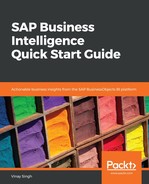SAP Automated Analytics provides business analysts and data scientists with a fully automated process that simplifies the setup of the data and the settings for the algorithms without sacrificing statistical validity.
SAP Automated Analytics has the following features:
- Automated data encoding
- Regression/classification
- Segmentation
- Forecasting
- Association rules
- Social network analysis
- Recommendations
SAP data manager allows you to create dynamic datasets that you can move through time. This improves productivity when developing models and applying models in different time frames. This approach is optimized to work with SAP Model Manager.
SAP Model Manager is a web server-based thin-client application that allows us to automate modeling activity. Several users can work on the same modeling project with the help of SAP Model Manager by scheduling the following types of tasks:
- Retraining a model
- Applying a model to a new dataset
- Detecting model deviations
- Detecting the deviation of a dataset
One of the limitations of SAP Model Manager is its platform: it's only supported on Microsoft Windows; if our modeling server is deployed on Unix, we would need an additional Windows server.
Both Expert Analytics and Automated Analytics have tight integration to SAP HANA. Analytical Predictive Library comprised of data mining functions from Automated Analytics that were made available within SAP HANA for in-database model development. Automated Analytics algorithms can be executed in SAP's in-memory database HANA. This provides the power to analyze millions of records in seconds.
SAP Lumira visualization enables analysts to visually explore data, produce dashboards, and share this insight with colleagues. With the help of sophisticated algorithms, SAP Expert Analytics helps us to understand and take the next step in the business and modeling outcomes.
SAP Expert Analytics has the following features:
- It performs statistical analysis on our data to understand trends and detect outliers in our business data
- It can access almost any data due to the depth of connectivity
- It allows users to build models and apply to the scenarios so that they can forecast potential future outcomes
- It uses huge data volumes and in-memory processing as it's optimized for SAP HANA
- Expert Analytics is more flexible and has better visualizations but requires more skill and experience to use correctly
R integration is a programming language for data scientists. In SAP Expert Analytics, you can customize algorithms written in R integration. Some of the salient features of R integration with SAP Expert Analysis are as follows:
- Drag and drop and no coding
- Custom R algorithms programming
- Access to over 5,000+ algorithms and packages
- More algorithms and packages than SAS, SPSS, and StatSoft
- A growing number of data analysts in the industry, government, consulting, and academia are now using R
- Embedding R scripts within SAP HANA database execution
The Predictive Analysis Library (PAL) is designed to provide high performance on big data, and is mainly targeting real-time analytics. It's a built-in C++ library that's designed to perform in-memory data mining and statistical calculations.
Cross-Industry Standard Process for Data Mining (CRISP-DM) was developed in 1996 by Daimler Chrysler, NCR, and ISL. The idea was to map business understanding and data understanding phases. On the flip side, it doesn't the next steps after deployment.Below is the graphical representation of Cross Industry Standard process for Data Mining showing the different phases .

